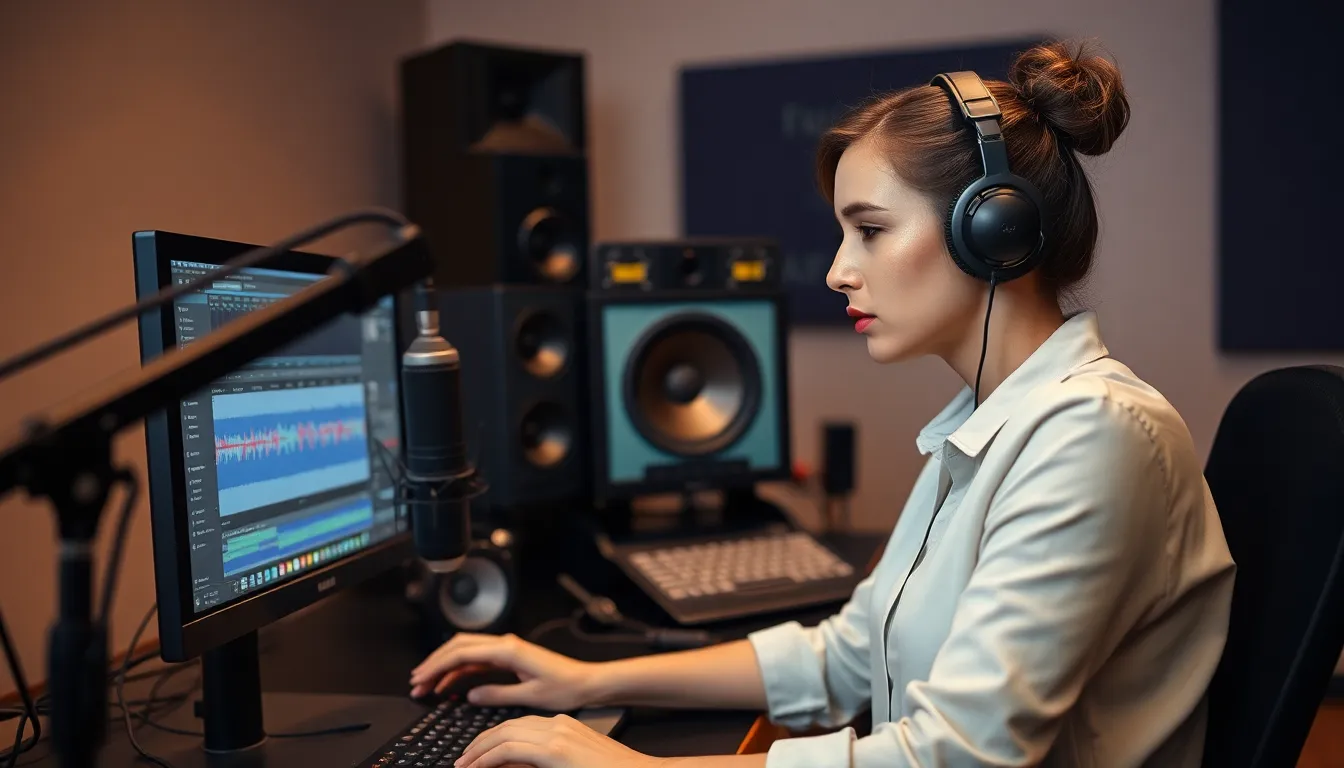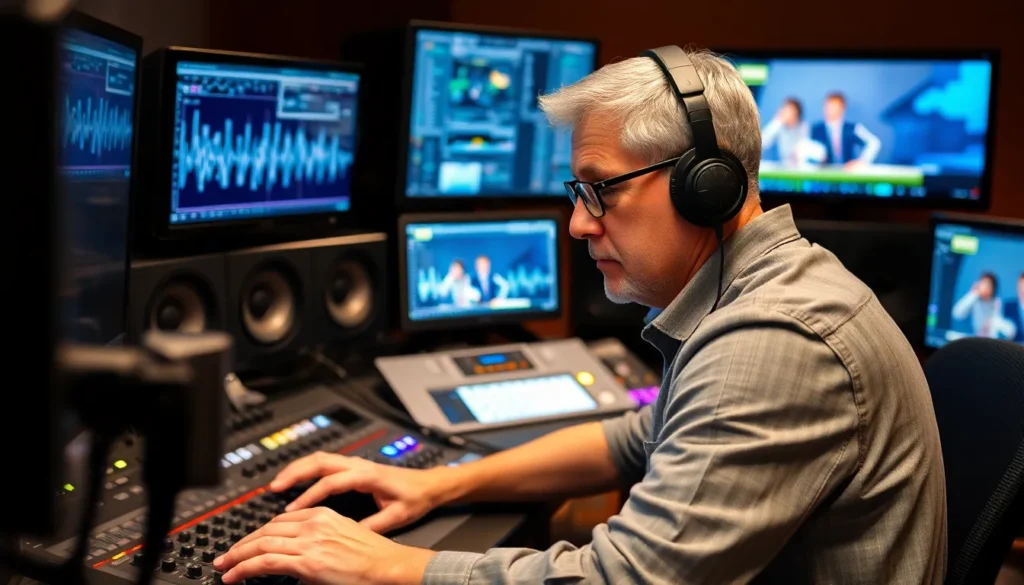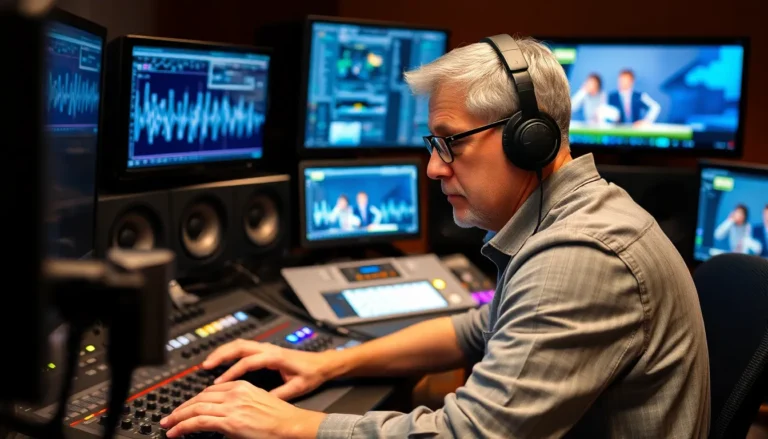Imagine watching your favorite movie only to find the characters’ lips moving like they’re auditioning for a silent film. Voice over sync is the unsung hero of audio-visual magic, ensuring that what you hear matches what you see. It’s like the perfect dance partner—if one stumbles, the whole performance falls flat.
In today’s fast-paced digital world, nailing that sync isn’t just a nice-to-have; it’s essential. Whether it’s for films, commercials, or video games, getting the timing right can make or break the viewer’s experience. So, grab your popcorn and get ready to dive into the world of voice over sync, where every word counts and every second matters.
Table of Contents
ToggleUnderstanding Voice Over Sync
Voice over sync refers to the alignment of audio narration with visual content in various media formats. Perfect synchronization enhances the overall narrative and maintains audience engagement.
What Is Voice Over Sync?
Voice over sync describes the precise timing of voice recordings that align with corresponding visual actions. Achieving this synchronization involves ensuring that dialogue matches mouth movements, actions, and scene changes. Professionals use specialized software for accuracy, capturing nuances of voice character and emotion that complement visuals. This meticulous process is essential to produce a seamless viewing experience.
Importance of Voice Over Sync in Media
Voice over sync plays a crucial role in media production, impacting viewer engagement significantly. Accurate synchronization fosters clarity in storytelling and helps convey emotions effectively. Audiences connect more deeply with characters when audio aligns correctly with visuals. Inadvertent mismatches can confuse viewers, detracting from the narrative experience. Strong voice-over sync becomes especially critical in genres like animation, where characters rely on precise audio to convey their personalities.
Techniques for Achieving Voice Over Sync

Achieving voice over sync relies on precise timing and advanced techniques. Two prominent methods exist: manual syncing and automated tools.
Manual Syncing Methods
Manual syncing requires attention to detail during the recording process. Voice actors review scenes, matching their audio to character movements. Editors adjust audio tracks in post-production for precise alignment. They often use visual cues, such as lip movements, to guide their adjustments. Experience plays a significant role, as skilled editors can detect even minor discrepancies. Additionally, performing multiple takes can enhance sync accuracy, allowing for better options during editing. Lastly, collaboration between voice actors and sound editors leads to improved outcomes.
Automated Syncing Tools
Automated syncing tools streamline the process and increase efficiency. These software options utilize algorithms to analyze audio and visual content. They automatically adjust timing, making it easier to achieve synchronization. AI-powered tools significantly reduce manual labor, aligning voice tracks with visual cues seamlessly. Many industry-standard programs offer various features tailored for specific project needs. For instance, some tools provide real-time playback to quickly identify discrepancies. Furthermore, these tools facilitate batch processing, handling multiple files at once, which saves time and resources.
Common Challenges in Voice Over Sync
Achieving voice over sync presents several challenges that impact the final product. Timing issues and audio quality concerns significantly influence the effectiveness of synchronization.
Timing Issues
Timing remains a critical factor in voice over sync. Misalignment between audio and visual elements often disrupts the viewer’s experience. Actors must deliver lines at the right moment, matching the characters’ mouth movements. Editors may face difficulty if actors’ performance varies during recording sessions, leading to inconsistencies. Precision becomes paramount, especially during rapid dialogue exchanges or action sequences. Failure to achieve accurate timing can confuse viewers, diminishing emotional impact and narrative clarity.
Audio Quality Concerns
Audio quality poses another significant challenge in maintaining voice over sync. Poor recording conditions can introduce background noise or distortion, complicating synchronization efforts. Clear and crisp audio enhances the emotional tone of scenes, while muddled tracks can detract from character expression. Voice actors need to perform in soundproof environments to counteract ambient noise. Editors often employ sound editing tools to address quality issues, but excessive corrections can alter the original performance. Ensuring optimal audio quality is essential for a cohesive and engaging viewer experience.
Best Practices for Perfect Voice Over Sync
Achieving perfect voice over sync requires attention to detail during both pre-production and post-production phases.
Pre-Production Preparation
Preparation lays the foundation for successful voice over sync. Actors should practice their lines to ensure natural delivery that aligns with character movements. Script read-throughs help identify timing challenges early, allowing adjustments before recording. Directors must provide clear direction on emotional tone and pacing, ensuring that voice actors understand the intended feelings behind the dialogue. Recording in a controlled environment minimizes noise and distractions, improving audio quality. With a detailed plan, producers can tackle potential issues ahead of time, leading to a smoother recording process and enhancing alignment between audio and visuals.
Post-Production Editing Tips
Editing plays a crucial role in refining voice over sync. First, editors should carefully review each scene to assess audio alignment with visual cues. Delay adjustments may be necessary, requiring precise audio editing to enhance timing. Noise reduction tools help improve audio clarity while maintaining the original voice character. Layering different audio tracks can offer more depth, but balancing them against the visuals is vital for coherence. Continuous playback during the editing process allows for detecting discrepancies that might disrupt viewer engagement. Checking audio levels is essential to ensure consistent volume throughout the production, enhancing the overall listening experience without sacrificing quality.
Voice over sync is an essential component of effective media production. It not only enhances the viewer’s experience but also deepens the emotional connection to characters and stories. Achieving perfect synchronization requires a blend of skillful timing and high-quality audio, whether through manual methods or automated tools.
By prioritizing preparation and collaboration, production teams can overcome common challenges and ensure a seamless integration of audio and visual elements. With the right techniques and attention to detail, voice over sync can elevate any project, making it more engaging and memorable for audiences.




